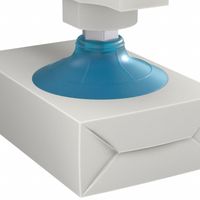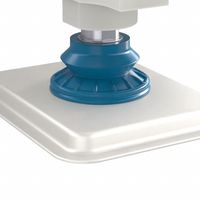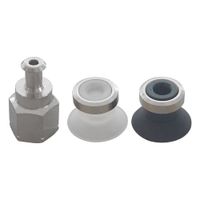Call +(254) 703 030 000 / 751 483 999 / 721 704 777
- Home
- Pneumatics
- Vacuum System Components
- Vacuum Pads Pad Assemblies
.....Read More
Frequently Asked Questions
What are vacuum pads and how do they work?
Vacuum pads, also known as suction cups or vacuum cups, are devices used to grip, hold, or manipulate objects through the application of a vacuum. They are commonly used in various industries, including manufacturing, packaging, and robotics, to handle materials such as glass, metal, plastic, and wood.
A vacuum pad typically consists of a flexible, often rubber or silicone, cup that can conform to the surface of the object it is intended to hold. The working principle of vacuum pads is based on creating a pressure differential between the inside of the cup and the ambient atmosphere. When the vacuum pad is pressed against a surface, the air inside the cup is evacuated, usually by a vacuum pump or an ejector, creating a low-pressure area. The higher atmospheric pressure outside the cup then pushes the pad against the object, generating a strong grip.
The effectiveness of a vacuum pad depends on several factors, including the material and design of the pad, the surface texture of the object, and the level of vacuum applied. Pads come in various shapes and sizes to accommodate different applications, from flat surfaces to curved or irregular shapes. Some vacuum pads are equipped with bellows or other features to enhance flexibility and adaptability to different surfaces.
Vacuum pads are valued for their ability to handle delicate or irregularly shaped items without causing damage. They are used in automated systems for tasks such as pick-and-place operations, assembly lines, and material handling. Their efficiency and versatility make them an essential component in modern industrial processes, contributing to increased productivity and reduced manual labor.
What materials are vacuum pads made from?
Vacuum pads, also known as suction cups, are made from a variety of materials, each chosen for specific properties that suit different applications. Common materials include:
1. **Rubber (Natural and Synthetic):** Rubber is widely used due to its flexibility, durability, and good grip. Natural rubber offers excellent elasticity and resilience, while synthetic rubbers like nitrile and neoprene provide resistance to oils, chemicals, and temperature variations.
2. **Silicone:** Silicone vacuum pads are favored for their high-temperature resistance and flexibility. They are suitable for applications involving heat or where a non-marking material is required, such as in the handling of delicate or polished surfaces.
3. **Polyurethane:** Known for its toughness and abrasion resistance, polyurethane is used in applications where durability is crucial. It provides a good balance between flexibility and strength, making it suitable for heavy-duty tasks.
4. **Vinyl (PVC):** Vinyl is used for its cost-effectiveness and chemical resistance. It is suitable for general-purpose applications but may not perform well under high temperatures or in contact with certain chemicals.
5. **EPDM (Ethylene Propylene Diene Monomer):** EPDM is chosen for its excellent weather, ozone, and UV resistance. It is ideal for outdoor applications and environments with exposure to harsh weather conditions.
6. **Fluoroelastomers (e.g., Viton):** These materials are used for their superior chemical resistance and high-temperature stability. They are suitable for handling aggressive chemicals or in high-temperature environments.
7. **Thermoplastic Elastomers (TPE):** TPEs combine the properties of rubber and plastic, offering flexibility, durability, and ease of processing. They are used in applications requiring a balance of these properties.
The choice of material depends on factors such as the nature of the surface being handled, environmental conditions, and specific application requirements.
How do you choose the right vacuum pad for a specific application?
To choose the right vacuum pad for a specific application, consider the following factors:
1. **Material Compatibility**: Select a pad material that is compatible with the surface of the object being handled. Common materials include rubber, silicone, and polyurethane, each offering different levels of flexibility, temperature resistance, and chemical compatibility.
2. **Surface Texture**: For smooth surfaces, flat pads are suitable, while textured or uneven surfaces may require bellows or multi-bellows pads to ensure a secure grip.
3. **Load Capacity**: Determine the weight of the object to be lifted and choose a pad with sufficient load capacity. This ensures safety and efficiency in handling.
4. **Shape and Size**: The shape (round, oval, rectangular) and size of the pad should match the object's surface area to maximize contact and suction force.
5. **Environmental Conditions**: Consider the operating environment, including temperature, humidity, and exposure to chemicals. Choose a pad that can withstand these conditions without degrading.
6. **Application Speed**: For high-speed applications, select pads with quick-release features to enhance cycle times and productivity.
7. **Vacuum Level**: Ensure the pad can maintain the required vacuum level for the application. This involves considering the porosity of the material being handled.
8. **Mounting Style**: Choose a mounting style (threaded, push-in, or flange) that fits the existing equipment and allows for easy installation and replacement.
9. **Durability and Maintenance**: Consider the pad's durability and ease of maintenance, especially in high-wear applications, to minimize downtime and replacement costs.
10. **Cost**: Balance the cost with performance requirements, ensuring the pad meets the application's needs without unnecessary expense.
By evaluating these factors, you can select a vacuum pad that optimizes performance, safety, and cost-effectiveness for your specific application.
What are the differences between various types of vacuum pads, such as sheet metal, automotive, and universal?
Vacuum pads, also known as suction cups, are designed to handle different materials and applications, and their differences are primarily based on the material, shape, and specific use-case requirements.
1. **Sheet Metal Vacuum Pads**: These are specifically designed for handling flat, smooth surfaces like metal sheets. They often have a flat or slightly concave design to maximize surface contact and ensure a strong grip. The material is usually durable rubber or polyurethane to withstand the weight and sharp edges of metal. They may also have a textured surface to prevent slipping and are often used in manufacturing and assembly lines where metal sheets are frequently moved.
2. **Automotive Vacuum Pads**: These pads are tailored for the automotive industry, where they handle a variety of surfaces, including painted, glass, and plastic parts. They are typically made from softer materials like silicone or nitrile to avoid damaging delicate surfaces. Automotive pads may have specialized designs, such as bellows or multi-bellows, to conform to curved surfaces and provide a secure grip on irregular shapes. They are used in processes like assembly, painting, and glass installation.
3. **Universal Vacuum Pads**: As the name suggests, these pads are versatile and can be used across various industries and applications. They are designed to handle a wide range of materials, from smooth to slightly textured surfaces. Universal pads are often made from a medium-hardness rubber that balances grip strength and surface protection. They come in various shapes, such as flat, bellows, or oval, to accommodate different tasks. These pads are ideal for general-purpose use where specific material handling is not required.
Each type of vacuum pad is engineered to optimize performance for its intended application, ensuring efficiency, safety, and reliability in material handling tasks.
How do you maintain and clean vacuum pads to ensure longevity and performance?
To maintain and clean vacuum pads effectively, follow these steps:
1. **Regular Inspection**: Frequently check vacuum pads for wear, cracks, or damage. Replace any pads that show signs of deterioration to prevent performance issues.
2. **Cleaning**: Use a soft cloth or sponge with mild soap and water to clean the pads. Avoid harsh chemicals that can degrade the material. Rinse thoroughly to remove any soap residue.
3. **Drying**: After cleaning, ensure the pads are completely dry before use. Moisture can affect suction performance and lead to slippage.
4. **Debris Removal**: Regularly remove any debris or particles that may have accumulated on the pads. Use a soft brush or compressed air to gently dislodge dirt without damaging the surface.
5. **Surface Compatibility**: Ensure the pads are suitable for the surfaces they contact. Using the wrong type of pad can lead to excessive wear or reduced suction.
6. **Storage**: Store vacuum pads in a clean, dry environment away from direct sunlight and extreme temperatures. This prevents material degradation and maintains elasticity.
7. **Lubrication**: If applicable, lightly lubricate any moving parts associated with the vacuum pads to ensure smooth operation. Use manufacturer-recommended lubricants.
8. **Avoid Overloading**: Do not exceed the weight capacity of the vacuum pads. Overloading can cause premature wear and reduce lifespan.
9. **Regular Testing**: Periodically test the vacuum pads to ensure they maintain proper suction. This can be done by lifting a test object and checking for slippage.
10. **Follow Manufacturer Guidelines**: Adhere to any specific maintenance instructions provided by the manufacturer to ensure optimal performance and longevity.
By following these steps, you can maintain the efficiency and extend the life of your vacuum pads.
What are the safety considerations when using vacuum pads in automated systems?
When using vacuum pads in automated systems, several safety considerations must be addressed to ensure safe and efficient operation:
1. **Load Capacity**: Ensure the vacuum pads are rated for the weight and type of material being handled. Overloading can lead to failure and potential injury.
2. **Material Compatibility**: Use vacuum pads made from materials compatible with the workpiece to prevent damage or contamination.
3. **Surface Condition**: The surface of the workpiece should be clean and smooth to ensure a good seal. Rough or dirty surfaces can reduce suction efficiency.
4. **Vacuum System Integrity**: Regularly inspect hoses, seals, and connections for leaks or wear that could compromise the vacuum system's performance.
5. **Emergency Release Mechanism**: Implement an emergency release mechanism to quickly disengage the vacuum in case of system failure or power loss.
6. **Redundancy**: Consider using multiple vacuum pads or a backup system to maintain grip if one pad fails.
7. **Environmental Conditions**: Be aware of temperature, humidity, and other environmental factors that might affect the vacuum pad's performance.
8. **Operator Training**: Ensure operators are trained in the safe use and maintenance of vacuum systems, including emergency procedures.
9. **Regular Maintenance**: Establish a routine maintenance schedule to check for wear and tear, ensuring all components are in good working order.
10. **Safety Interlocks**: Use safety interlocks to prevent the system from operating if the vacuum level is insufficient.
11. **Monitoring Systems**: Implement sensors and alarms to monitor vacuum levels and alert operators to potential issues.
12. **Ergonomics and Accessibility**: Design systems to minimize operator strain and ensure easy access for maintenance and emergency interventions.
13. **Compliance with Standards**: Adhere to relevant safety standards and regulations to ensure the system is compliant with industry best practices.
How do you install and replace vacuum pads and pad assemblies on robotic arms?
To install and replace vacuum pads and pad assemblies on robotic arms, follow these steps:
1. **Safety First**: Ensure the robotic arm is powered off and disconnected from any power source. Wear appropriate personal protective equipment.
2. **Access the Vacuum Pad**: Locate the vacuum pad assembly on the robotic arm. This is typically at the end effector or tool end of the arm.
3. **Remove the Old Pad**: If replacing an existing pad, gently detach it. This may involve unscrewing or unclipping the pad from its holder. Be cautious not to damage any connectors or the arm itself.
4. **Inspect Components**: Check the vacuum lines, connectors, and the pad holder for any wear or damage. Replace any worn components to ensure optimal performance.
5. **Select the Correct Pad**: Choose a vacuum pad that matches the specifications required for your application, considering factors like size, material, and load capacity.
6. **Install the New Pad**: Attach the new vacuum pad to the holder. This may involve screwing it in place or snapping it into a clip, depending on the design. Ensure it is securely fastened.
7. **Connect Vacuum Lines**: Reattach any vacuum lines to the new pad. Ensure all connections are tight to prevent air leaks.
8. **Test the Assembly**: Power on the robotic arm and test the vacuum pad assembly. Check for proper suction and ensure the pad holds and releases objects as expected.
9. **Calibration**: If necessary, recalibrate the robotic arm to account for any changes in weight or dimensions due to the new pad.
10. **Documentation**: Record the maintenance activity, including the date, type of pad installed, and any observations during the process.
By following these steps, you ensure the vacuum pad assembly is correctly installed and operational, maintaining the efficiency and safety of the robotic arm.




